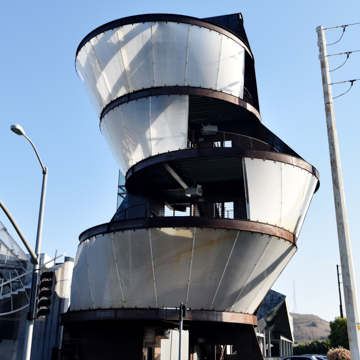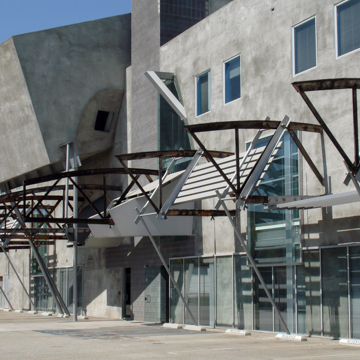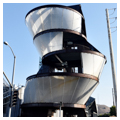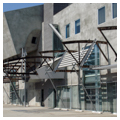Located on the southeastern edge of Culver City in an industrial area next to the Ballona Creek, the Hayden Tract is a collection of buildings that are among the most avant-garde iterations of architecture in Southern California. Home to many film, media, and advertising firms, and designed by Eric Owen Moss, these repurposed former warehouses have been transformed into provocative structures that in many ways epitomize the boldness of the Los Angeles School of Architecture that Moss helped pioneer over the last three decades.
The Hayden Tract is a small city within itself that has evolved one building at a time. The genesis of the Hayden Tract as we know it today began with real estate developers Frederick and Laurie Samitaur Smith. By the 1970s, the various 1940s-era warehouses and factories of the Hayden Tract were a decaying group of buildings. The Samitaur Smiths envisioned transforming the tract during the 1980s but were uncertain how to do so until they met Moss in 1986, when the architect became one of their tenants. The duo believed real estate development could be a vehicle for social change, and Frederick recalled that he realized Moss was the correct architect for this mission when he walked into Moss’s office “and found him reading T.S. Eliot.”
In the late 1980s, Moss began renovating one of the former industrial buildings into a site intended to house media-related tenants. One of the first structures that Moss completed at the Hayden Tract is the Paramount Laundry–Lindblade Tower–Gary Group Complex, built between 1987 and 1990. Moss’s progressive design excited the Samitaur Smiths so much they extended their partnership with Moss. By the mid-1990s, over six other projects at the same location were underway.
The Samitaur Smiths’ financial support of Moss over the last twenty-five years has enabled him to create an expansive landscape of over thirty buildings within a few square blocks. Moss has continued to repurpose and reshape the old warehouses into new structures with exposed steel beams, geometric glass, and unique shapes. Each new structure seems to outdo the previous and the names of the buildings often reflect their boldness. Some of the monikers include the Box, Stealth, the Umbrella, the Beehive, Pterodactyl, Slash, and Backslash. Within these designs, Moss creates open courtyards, unique conference rooms, and iconic entryways that further define the neighborhood. Moss calls these collective structures “Conjunctive Points.”
Moss’s architectural flair has slowly but surely led to the Hayden Tract becoming one of Southern California’s most prestigious addresses for advertising and media firms. With the April 2016 completion of the Expo Line train connecting downtown Los Angeles to Santa Monica, the Hayden Tract became a notable sight midway along the line. Perhaps its most iconic structure is the seventy-two-foot tall observation tower on the northwestern edge of the Hayden Tract on the corner of Hayden and National boulevards. Called “Samitaur Tower,” the obelisk is visible from the adjacent Expo Line and cars driving by on National Boulevard. The tower includes five open platforms that are wrapped in translucent acrylic screens. The screens are capable of displaying video art or electronic media.
Most of Moss’s large buildings are located within the Hayden Tract, although he has also designed a number of houses across the Westside of Los Angeles. His work has been praised as an assemblage of separate buildings that achieve unity through central open space and the use of geometric designs in unfinished metal, concrete, and glass. This small pocket of architectural innovation has sustained his global visibility, and he is often considered part of the same group of Los Angeles–based experimental architects such as Frank Gehry and Thom Mayne who helped to move the region’s design community away from midcentury modernism.
References
Giaconia, Paola. Eric Owen Moss: The Uncertainty of Doing.Milan: Skira, 2006.
Goldberger, Paul. “Neighborhood Watch: Eric Owen Moss and Culver City.” New Yorker, December 20-27, 2010.
Jencks, Charles. Heteropolis: Los Angeles, the Riots and the Strange Beauty of Hetero-architecture. London: Academy Editions, 1993.
Moss, Eric Owen. Who Says What Architecture Is? Los Angeles: SCI-Arc Press, 2007.
Steele, James. Los Angeles Architecture: The Contemporary Condition. London: Phaidon, 1993.

















